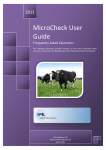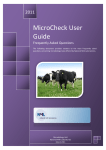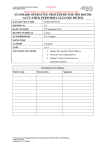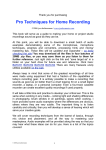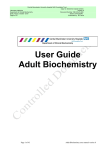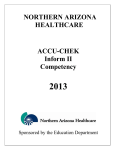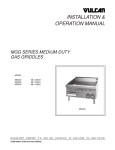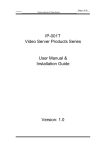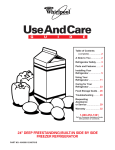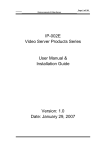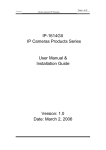Download Troubleshooting milk flavor problems
Transcript
College of Agricultural Sciences • Cooperative Extension Troubleshooting milk flavor problems Virginia Ishler and Bob Roberts1 1 Department of Food Science Department of Dairy and Animal Science The Pennsylvania State University 324 Henning Building University Park, PA 16802 (814) 865-5491 • FAX (814) 865-7442 www.das.psu.edu/teamdairy/ _____________________________________________________________________________________________________________________________________________________________________________________________________________ Topics include: Introduction Classification of off-flavors Rancid flavor Farm oxidized flavor Feed flavor Unclean flavor Malty High acid Putrid _______________________________________________________________________________________________ DAS 02-39 INTRODUCTION ________________________________________________________________________________________________________________________________________________________________________________________________________________________________ Producing a high quality food product begins at the farm level. Milk quality cannot be improved after it leaves the farm. Dilution or processing will not make good milk out of bad. Prevention is the only way to assure milk is of good quality and flavor. Sometimes certain nutrition programs or management practices on the farm can cause offflavor problems in milk. This can have long-term ramifications with consumers because of a poor tasting product. This can undermine consumer confidence in dairy products. Therefore, it is in everyone’s interest to prevent these occurrences from happening regardless of the source. This fact sheet will address the common off-flavor problems and how they can be prevented. CLASSIFICATION OF OFF-FLAVORS ________________________________________________________________________________________________________________________________________________________________________________________________________________________________ Off-flavors commonly found in milk can be classified in three basic categories – the ABC’s of off-flavor development. 1. Absorbed – feedy, barny, cowy, unclean, weedy, and musty. 2. Bacterial – acid, malty, unclean, fruity, and putrid. 3. Chemical – cowy (ketosis), rancid, oxidized, sunlight, and medicinal. Absorbed flavor defects can develop before, during and after milking. It can occur when milk is left uncovered in the consumer’s refrigerator or kept in cold rooms and dairy cases with other odorproducing foods. Bacterial degradation results from bacteria that get into the milk upon contact with improperly washed or sanitized equipment, from external contamination, and is made worse by improper cooling. Infection of cows should not be considered as a source of high bacteria counts until all other causes have been eliminated. Chemical defects can occur both before and after milking. The cowy or ketone flavor is the result of the animal suffering from ketosis. A foreign flavor can be caused by medications, a reaction to pesticides, disinfectants, or any number of contaminants. Rancidity and oxidation result from the degradation of milkfat. RANCID FLAVOR ________________________________________________________________________________________________________________________________________________________________________________________________________________________________ A soapy-bitter taste is identifiable with rancidity. There appears to be a seasonal affect with the months between July and September having the highest occurrences. Rancidity is caused by a chemical development, which continues until the milk is pasteurized. It involves lipase and other enzymes, which react with the milkfat to form free fatty acids. The key to prevention is to have intact membranes around milkfat globules. Causes of rancid flavor are those things that result in weakened or broken milkfat globule membranes. Some farm related causes include: 1. Lack of adequate protein in the diet. 2. Not feeding enough total energy for the level of milk produced. 3. Milking cows longer than 305 days. 4. Added stress when milking cows more than two times per day. 5. Air leaks in pipeline milkers. 6. Flooding of pipelines and receiver jars. 7. Partial or less than every other day collection of milk from farms. 8. Freezing in the bulk tank. 9. Over agitation in the bulk tank. Some non-farm related causes include: 1. Holding raw milk in processing plants more than 48 hours after collection. 2. Failure to empty and wash raw milk storage tanks every processing day. 3. Air leaks in pipes. 4. Running pumps in a starved condition. 5. Homogenization prior to pasteurization. ________________________________________________________________________________________________________________________________________________________________________ DAS 02-39 Troubleshooting milk flavor problems 1 RANCID FLAVOR, CONT. ________________________________________________________________________________________________________________________________________________________________________________________________________________________________ To correct a rancidity problem, start with the milk as processed and proceed back to the farm. Load samples of all milk received at the processing plant should be tasted regularly after laboratory pasteurization of 145oF for 30 minutes. Milk samples should be held for 48 hours after collection from farms and then tasted. Sometimes there is a slight butyric acid odor associated with rancid milk, but most of the time samples must be tasted to determine rancidity. At the farm level, there are equipment observations that can be made. Check the pipeline and receiver jar during milking for foaming or flooding, or if the milk pump runs continuously. Check all fittings on pipeline milkers for tightness and close fit. Minimize air injection at claws and avoid over milking cows. No more than two units should be used on a 1.5-inch pipeline milker for each slope, i.e. two units on each side for a double slope line. Do not milk straight through weigh jars. Check the bulk tank for evidence of freezing or churning. In herds with many late lactation animals, it may be necessary to sample milk from all four quarters on animals milking in excess of 305 days. The milk should be stored for 48 hours and then tasted. If milk samples taste rancid, some of their milk may need to be diverted from the bulk tank. Maintain milk quality by keeping the herd somatic cell counts below 250,000 per ml. Check the ration program for proper fiber levels and particle size, fat content, and protein and energy levels appropriate for animal production. Acid Degree Value (ADV) Rancidity is characterized by the release of free fatty acids because of the action of the lipase enzyme. When consumers taste rancid milk, they are detecting the short chain fatty acids. An Acid Degree Value test can be used to measure the presence of long chain fatty acids. There is about a 70 percent correlation between flavor and ADV. ADVs are more meaningful for raw milk samples from individual farms. In mixed milk on trucks or in silo tanks the effect of milk from one farm is minimized. Rancid milk from one farm may cause a rancid flavor in the entire tank. Therefore, ADV results from mixed milk are not very meaningful. Milk samples from individual farms should have ADVs of less than 0.80. When results exceed 1.00, the milk will have a soapy-bitter taste. Some farms may have ADVs above 1.00 at the time of processing. ADVs should be conducted at the time the milk is processed rather than when the milk is received at the plant. When ADV results exceed 1.20, one can expect consumer complaints and a negative effect on consumption and sales. Action should be taken when samples results are above 1.00. FARM OXIDIZED FLAVOR ________________________________________________________________________________________________________________________________________________________________________________________________________________________________ Oxidized flavor is also a reaction of milkfat. Milk with a cardboardy or metallic taste is more common in milk during the winter and early spring. The offflavor can be detected in raw milk, but sometimes not until two days after collection. It can also be a problem in any pasteurized milk or dairy product that has not been flavored. Causes are different than for the light induced flavor of milk purchased at stores, although the taste is similar. Increased susceptibility of milk to the chemical development of oxidation is due primarily to less antioxidant in the milk. The main cause is the decreased amount of vitamin E, an antioxidant, in stored forages, which reduces the amount found in milk. Once milkfat has begun to oxidize, the intensity will continue to increase overtime. The taste may not be apparent in the milk, but may be detected in high fat products such as butter or vanilla ice cream. In the majority of cases, oxidized flavor problems start at the farm. There are several causes of oxidized flavor on farms or in processing plants. They include: 1. Equipment surfaces improperly cleaned. 2. Minerals in the water supply. 3. Acid water and copper tubing. 4. Use of chlorine sanitizers. 5. Stored forages low in vitamin E. 6. Feeding high levels of vegetable fats, i.e. soybeans, cottonseeds. ________________________________________________________________________________________________________________________________________________________________________ DAS 02-39 Troubleshooting milk flavor problems 2 FARM OXIDIZED FLAVOR, CONT. ________________________________________________________________________________________________________________________________________________________________________________________________________________________________ It is usually necessary to correct all causes of the problem before the off-flavor will disappear. Feeding extra vitamin E will not overcome excessive copper or iron in the water supply used to wash equipment or compensate for dirty milking equipment. There are corrective and preventative measures that can be taken. They include the following: 1. Wash all surfaces that are exposed to milk after every use. Any milkfat or protein left in a bulk or storage tank, pipeline, milker unit, or pump oxidizes readily. Check all equipment on the farm, in truck tanks, and receiving rooms to be sure that they are clean. 2. The presence of copper or iron in the water used to wash equipment will cause oxidized flavor. As little as 0.1 ppm copper or iron may cause a problem. Unless another water supply is available, treatment is necessary. 3. Water in mining areas may be acidic. When copper tubing is used to transport the water to the milk house, some copper may be removed. It will settle on equipment surfaces and cause oxidation when milk comes into contact. Copper tubing should not be used for water in the milk house if the farm has acid water. 4. Sanitizers are oxidizing agents, so solutions should be completely drained from all equipment. Chlorine precipitates metals, so iodine sanitizers are recommended for equipment when an oxidized flavor problem is present. However, it is not appropriate to rinse with water after sanitizing. 5. Provide some green feed, i.e. pasture or greenchop to milking cows from May to October. These contain high levels of betacarotene and vitamin E. 6. Check the ration for adequate protein content. It should be appropriate for the level of milk being produced. Check that the milk protein content is normal. 7. Ingredients that increase the proportion of unsaturated fatty acids in the milk may increase the milk’s susceptibility to oxidation. 8. Nutritional problems, which depress the milkfat percent, often increase the unsaturation of the milkfat and make it more susceptible to oxidation. To correct milkfat depression, evaluate the ration for fiber le vels, particle size, fat content and source, and the cereal grain source (i.e. heat-treated, particle size, high moisture). Milkfat test is considered depressed when it falls more than 0.3 percent below breed average. 9. Light exposure of milk in a glass or plastic milk line will not cause an off-flavor problem. The exposure time to sunlight, daylight, or fluorescent light is too short. 10. When obvious causes have been corrected and the problem persists, add 1,000 or up to 7,000 International Units of vitamin E per animal daily for one to two weeks. This should be done only in extreme cases. Consult with a nutritionist before feeding these levels. FEED FLAVOR ________________________________________________________________________________________________________________________________________________________________________________________________________________________________ All feed flavors are absorbed through the cows system rather directly into the milk. Cows impart an odor and taste within 30 minutes of eating or breathing silage. It is strongest after about one hour. The odor and taste of grass or corn silage, legume hay, and brewer’s grains are the ingredients causing most of the problems. The two methods which odor can be transferred to milk is: • Nose or mouth lungs blood milk • Mouth digestive tract blood milk Strong silage odors in conventional barns or freestall housing areas can cause strong milk flavors when cows consume the offending feed. Adequate ventilation is essential. When feed flavor in milk is a problem, consider limiting the cows access to silage for two to four hours prior to milking. Offer any objectionable feeds to cows after milking. Check that ventilation is adequate in the feeding and housing areas. Some feed flavors can be removed by vacuum treatment, but this is not a common processing operation. ________________________________________________________________________________________________________________________________________________________________________ DAS 02-39 Troubleshooting milk flavor problems 3 UNCLEAN FLAVOR ________________________________________________________________________________________________________________________________________________________________________________________________________________________________ Some farm milk samples have an unpleasant, dirty after taste. This problem often occurs during winter. Frequently it is an absorbed flavor, like silage. Usually cows breathe air with a barny odor and transfer it to the milk. Dust, dirt and manure can cause an unclean flavor of milk. Cows and their surroundings must be kept clean. Milking equipment that has not been properly cleaned and sanitized may be a factor. Washing a cow’s udder with water and failing to dry them is one of the primary causes of unclean flavors. Be sure excess moisture is removed. In a small to average sized herd, a few animals with ketosis will cause an unclean flavor. This odor and taste is objectionable. Follow these suggestions to prevent unclean flavor problems in milk: 1. Keep floors, walls, and ceilings of milking and housing areas reasonably clean. 2. Provide adequate ventilation to eliminate stale odors. 3. Clip hair from the udder, teats, and flanks of milk cows. 4. Provide adequately bedded stalls so that cows may lie down. 5. Wash udder and teats with a sanitizer solution and dry prior to attaching milker units. 6. Clean and sanitize all milk handling equipment between uses. 7. In some circumstances it may be necessary to withhold milk from ketotic cows. MALTY ________________________________________________________________________________________________________________________________________________________________________________________________________________________________ Milk is an excellent growth medium for bacteria. It provides the nutrients and moisture and has a near neutral pH. Off-flavors are the results of bacterial growth (psychrotrophs). The type of bacteria is more important than the number. Psychrotrophs include many kinds of bacteria, all of which cause spoilage. Their ideal growth temperature is 65-70oF. Cold temperatures slow their growth, but do not kill them. At 45oF or above, bacterial growth is steady and off-flavors may be present in two to three days. Malty flavor tastes like Grapenut cereal. The cause is due to Streptococcus lactis in poorly cooled milk. The problem can be exacerbated when the milk from one bulk tank is mixed with that from many others in a truck tank, then in a plant raw milk storage tank. A sample of milk from a farm bulk tank not cooled for 12 hours will always have a high bacteria count. Malty flavor is generally a forerunner of a high acid flavor. It rarely develops in pasteurized milk. However, the characteristic flavor will remain after processing, although the flavor developed in raw milk. If not stopped by pasteurization, a malty flavor will later become high acid. HIGH ACID ________________________________________________________________________________________________________________________________________________________________________________________________________________________________ Bacterial flavors are not acceptable in milk for fluid or manufactured purposes. Sanitation is the key to preventing high acid flavors. Spoilage is due to bacterial action on lactose (milk sugar). All milk handling equipment surfaces should be washed after each use and sanitized just prior to reuse. This includes washing all milking units, pails, and pipelines on a twice per day basis. Bulk tanks must be washed each time they are emptied. Milk from the bulk tank should be picked up at least every other day. Longer time periods between pickup and partial emptying of a tank causes problems. Any milk left in a bulk tank for more than three days has the potential of high bacteria counts and off-flavors in fluid milk and manufactured products. Depending on milk composition, normal acidity test results can vary from 0.13 to 0.17 percent lactic acid. Before a hint of acid taste can be detected, this will usually rise to above 0.20 percent. Milk can safely be used for fluid purposes if acidity does not exceed this and there is no acid taste at the time of pasteurization. ________________________________________________________________________________________________________________________________________________________________________ DAS 02-39 Troubleshooting milk flavor problems 4 PUTRID ________________________________________________________________________________________________________________________________________________________________________________________________________________________________ Psychrotrophs cause flavors that are often described as stale, lack freshness, fruity, bitter, fermented or putrid. Frequently the titratable acidity may be near normal. Putrid flavors are the result of bacterial contamination, storage temperature above 40oF, and age. Spoilage of the milk is by bacterial action on the protein rather than on the lactose. Putrid milk will curdle, separate, and may smell rotten if left for a few days. The most common source of the problem is contamination in processing plants following pasteurization. Psychrotrophs do not generally survive pasteurization unless large numbers of the bacteria are present in the raw milk. Usually the contamination occurs because some part of the pumping, holding, and filling system is not properly cleaned and sanitized. Putrid flavors may originate in raw milk caused by contamination and holding raw milk for three or four days after collection from farms. Occasionally, retail samples of milk are found with putrid flavors and excellent bacteria counts. This can result when bacteria counts in the millions are present in raw milk at the time of pasteurization. Proper pasteurization and packaging without contamination eliminates most of the psychrotrophs. Although all the bacteria are destroyed, the spoiled flavor remains. No heating, vacuum treatment or other processing procedure will lessen the flavor. Reference: Guidelines for Preventing Off-Flavors in Milk. 1991. The Dairy Practices Council. Order from: DPC PO Box 866 Barre, VT 05641-0866 Phone: 802-476-3092 Web: http://www.dairypc.org/ This publication is available in alternative media on request. The Pennsylvania State University is committed to the policy that all persons shall have equal access to programs, facilities, admission, and employment without regard to personal characteristics not related to ability, performance, or qualifications as determined by University policy or by state or federal authorities. The Pennsylvania State University does not discriminate against any person because of age, ancestry, color, disability or handicap, national origin, race, religious creed, sex, sexual orientation, or veteran status. Direct all inquiries regarding the nondiscrimination policy to the Affirmative Action Director, The Pennsylvania State University, 201 Willard Building, University Park, PA 16802-2801; tel. (814) 863-4700/V, TDD (814) 865-1150/TTY. Where trade names appear, no discrimination is intended, and no endorsement by Penn State’s College of Agricultural Sciences is implied. Issued in furtherance of Cooperative Extension Work, Acts of Congress May 8 and June 30, 1914, in cooperation with the U. S. Department of Agriculture and the Pennsylvania Legislature. T. R. Alter, Director of Cooperative Extension, The Pennsylvania State University. ________________________________________________________________________________________________________________________________________________________________________ DAS 02-39 Troubleshooting milk flavor problems 5







